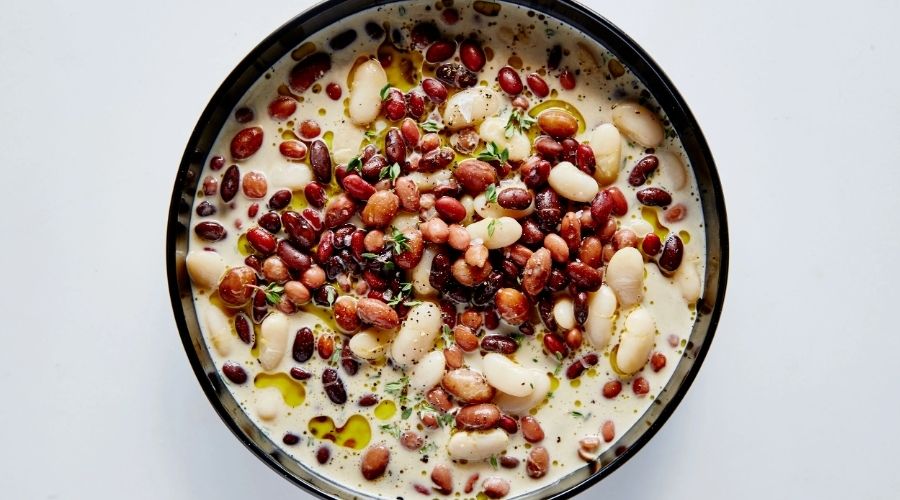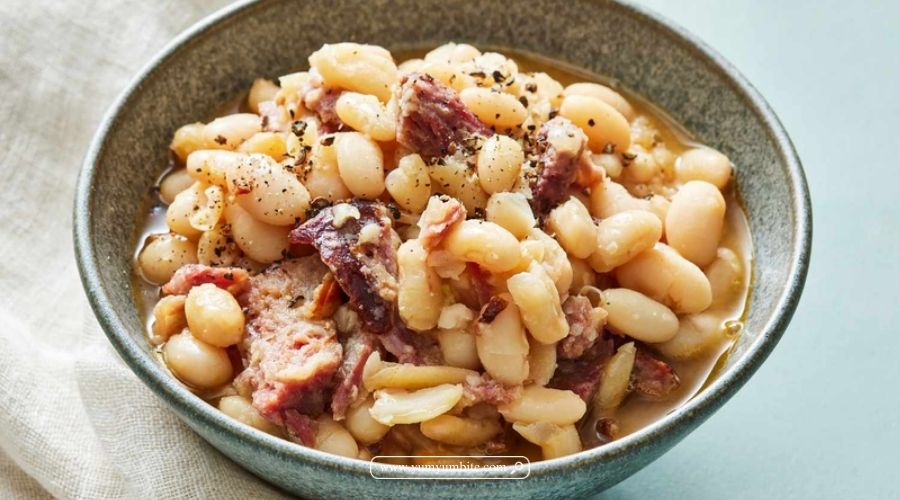Storing cooked beans properly is essential for maximizing their flavor, texture, and nutritional value.
Whether you’ve batch-cooked a pot of chili, whipped up a hearty bean salad, or simply prepared beans as a versatile side dish, knowing how to store them correctly can help you reduce waste and enjoy delicious meals throughout the week.
In this guide, we’ll explore effective storage techniques, safety tips, and best practices for keeping your cooked beans fresh, ensuring they remain a staple in your culinary repertoire.
Why Storing Cooked Beans Properly Matters
Properly storing cooked beans is essential for both safety and quality. Beans are a fantastic source of protein, fiber, and essential nutrients, making them a staple in many diets.
However, if not stored correctly, they can become a breeding ground for harmful bacteria, leading to foodborne illnesses.
When beans are left at room temperature for too long, they can spoil quickly, losing their texture and flavor.
Additionally, proper storage helps retain their nutritional value, ensuring that you get the most out of this versatile ingredient.
Using airtight containers and refrigerating or freezing cooked beans not only extends their shelf life but also makes meal prep more convenient.
This way, you can enjoy the benefits of beans without the worry of waste or health risks.
Complete Guide: How to Store Cooked Beans

Storing cooked beans properly is key to maintaining their freshness, flavor, and safety.
Follow these steps to ensure your beans are well-preserved for future meals.
1. Cool Them Down
After cooking, allow the beans to cool to room temperature. This step is crucial because placing hot beans directly into the fridge can raise the overall temperature, potentially compromising the safety of other stored foods.
Spread the beans out on a baking sheet or transfer them to a shallow dish to speed up the cooling process.
2. Choose the Right Storage Container
Select an airtight container to store your cooked beans. Glass containers or BPA-free plastic containers with tight-fitting lids are ideal, as they prevent moisture and air from entering.
If you plan to freeze the beans, consider using freezer-safe bags or containers to avoid freezer burn.
3. Portion Wisely
If you have a large batch of cooked beans, consider dividing them into smaller portions. This makes it easier to thaw only what you need for a meal, reducing waste.
Label each container with the date and type of beans for easy identification later.
4. Refrigeration
Store cooked beans in the refrigerator if you plan to use them within a few days. Generally, cooked beans can last in the fridge for about 3 to 5 days.
Keep them in an airtight container to maintain their freshness and prevent absorbing odors from other foods.
5. Freezing for Longer Storage
For longer storage, freezing is the best option. Cooked beans can be frozen for up to six months without significant loss of quality.
When freezing, ensure the beans are fully cooled and portioned. Remove excess air from freezer bags before sealing to prevent freezer burn.
6. Thawing and Reheating
When you’re ready to use your frozen beans, transfer them to the refrigerator to thaw overnight or use the microwave for quicker results.
If cooking from frozen, you can add them directly to soups or stews without thawing first.
When reheating, ensure the beans reach a safe temperature of 165°F (74°C) to eliminate any bacteria.
7. Safety Tips
Always check for signs of spoilage before consuming stored beans. If you notice an off smell, discoloration, or mold, discard them immediately.
Following proper storage methods not only keeps your cooked beans safe but also enhances your culinary experience.
By following these guidelines, you can enjoy the benefits of cooked beans while minimizing waste and ensuring food safety.
Whether you’re adding them to salads, soups, or casseroles, properly stored beans can be a delicious and nutritious addition to your meals.
What to Look for While Storing Cooked Beans?
When storing cooked beans, several key factors ensure their safety and quality. First, it’s important to cool the beans properly before storing them.
Placing hot beans directly in the fridge can raise the temperature inside and affect other stored foods.
Aim to cool them to room temperature, spreading them out on a baking sheet or in a shallow dish to facilitate this process.
Next, choose the right storage container. An airtight container is essential to prevent moisture and air from compromising the beans’ texture and flavor.
Glass or BPA-free plastic containers work well, and if you plan to freeze the beans, opt for freezer-safe bags or containers to avoid freezer burn.
Consider portion sizes as well. Dividing beans into smaller servings not only makes them easier to thaw but also helps prevent waste.
Label each container with the date and type of beans for easy reference.
Lastly, always monitor for signs of spoilage. Before consuming stored beans, check for any off smells, discoloration, or mold.
Proper storage techniques and vigilance will ensure that your cooked beans remain safe, flavorful, and nutritious for future meals.
How to Choose The Right Accessories for Storing Cooked beans?

Choosing the right accessories for storing cooked beans is essential for maintaining their freshness and safety.
Here are some key considerations to keep in mind:
1. Container Type
Opt for airtight containers that effectively seal out air and moisture. Glass containers are a great choice as they are non-reactive, easy to clean, and allow you to see the contents.
BPA-free plastic containers are also suitable, but make sure they are food-safe and sturdy enough for repeated use.
2. Size and Shape
Select containers that match the portion sizes you typically use. Smaller containers are ideal for single servings or meal prep, while larger ones can hold bigger batches.
Consider stackable options if space is a concern in your refrigerator or freezer.
3. Freezer-Safe Materials
If you plan to freeze cooked beans, ensure the containers are labeled as freezer-safe. Some plastic containers can become brittle at low temperatures, while freezer-safe bags are great for saving space.
Remove excess air from bags to prevent freezer burn.
4. Labels and Markers
Having a labeling system in place helps you keep track of what you’ve stored.
Use waterproof labels or freezer tape and a permanent marker to note the date and type of beans.
This practice not only prevents confusion but also helps you manage your pantry effectively.
5. Lid Quality
Check the quality of the lids, as they should fit securely to maintain an airtight seal.
Some containers come with locking mechanisms that provide added security, especially for liquid-based beans or stews.
6. Easy to Clean
Consider how easy the containers are to clean. Dishwasher-safe options can save time and effort, while containers with wide openings are easier to access and clean thoroughly.
By choosing the right accessories, you can ensure that your cooked beans stay fresh and delicious, ready for use in your favorite recipes whenever you need them.
How To Tell If Cooked beans Is Bad After Storing?
Determining whether cooked beans have gone bad after storing them is crucial for food safety. Here are some key signs to look for:
1. Smell
A sour or off odor is often the first indicator that cooked beans have spoiled. Fresh beans should have a neutral or slightly earthy aroma.
If they emit a strong, unpleasant smell, it’s best to discard them.
2. Appearance
Examine the beans closely. Freshly stored beans should look plump and intact. If you notice any discoloration, such as dark spots or a slimy film, these are signs of spoilage.
Mold growth, whether green, white, or fuzzy, is another clear indicator that the beans should not be consumed.
3. Texture
When cooked beans are fresh, they should have a firm but tender texture. If they feel mushy or overly soft, they may have deteriorated.
A slimy or sticky consistency is also a sign that the beans have gone bad.
4. Taste
If everything appears normal but you’re still unsure, you can perform a small taste test. If the beans taste off or have an unusual flavor, it’s safer to discard them.
5. Storage Time
Keep in mind how long the beans have been stored. Cooked beans can last in the refrigerator for about 3 to 5 days.
If they’ve been stored beyond this timeframe, it’s advisable to throw them away, even if they seem okay.
By being vigilant and observing these signs, you can ensure that you only consume safe and fresh cooked beans, minimizing the risk of foodborne illness.
1. How long can I store cooked beans in the refrigerator?
Cooked beans can be stored in the refrigerator for about 3 to 5 days. Ensure they are kept in an airtight container to maintain freshness and prevent odor absorption.
2. Can I freeze cooked beans?
Yes, you can freeze cooked beans for up to six months. Make sure to use freezer-safe containers or bags, removing excess air to prevent freezer burn.
3. Should I cool cooked beans before storing them?
Absolutely! Allow cooked beans to cool to room temperature before storing them in the refrigerator or freezer.
This helps prevent raising the temperature of other stored foods and reduces the risk of spoilage.
4. What type of container is best for storing cooked beans?
Airtight containers made of glass or BPA-free plastic are ideal for storing cooked beans. If freezing, use freezer-safe bags or containers designed to withstand low temperatures.
5. How can I tell if cooked beans have gone bad?
Signs of spoiled cooked beans include an off smell, discoloration, sliminess, or mold growth.
If you notice any of these signs, it’s best to discard the beans.
6. Can I store cooked beans with their cooking liquid?
Yes, you can store cooked beans in their cooking liquid to help maintain moisture.
Just ensure the container is airtight to prevent spoilage and absorb odors.
7. Is it safe to reheat cooked beans after storing them?
Yes, it is safe to reheat cooked beans. Ensure they reach an internal temperature of 165°F (74°C) before consuming to eliminate any bacteria.
Conclusion
In conclusion, mastering the art of storing cooked beans is a simple yet impactful skill that can enhance your cooking experience.
By following the right storage methods, you can keep your beans fresh and safe to eat, ready to elevate your favorite dishes.
From refrigeration to freezing, understanding how to store cooked beans ensures you make the most of this nutritious ingredient, minimizing waste while maximizing convenience.
So the next time you cook a batch of beans, you’ll be well-equipped to keep them delicious and ready for your next meal.
References
- https://alegumeaday.com/how-to-cook-beans/
- https://www.loveandlemons.com/how-to-cook-beans/
- https://www.ranchogordo.com/blogs/recipes/cooking-basic-beans-in-the-rancho-gordo-manner
- https://www.foodandwine.com/cooking-techniques/how-to-cook-dried-beans-simple-easy
- https://food.unl.edu/article/how-cook-dry-beans-scratch


